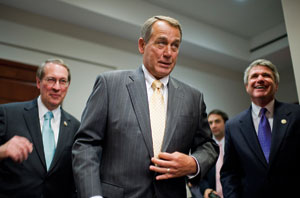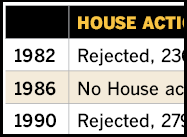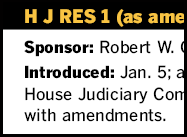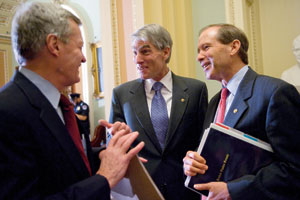CQ WEEKLY – COVER STORY
Nov. 5, 2011 – 12:00 p.m.
Balanced-Budget Amendment: Fix or Fantasy?
By Joseph J. Schatz, CQ Staff

|
||
|
To old-timers such as McCain, suggesting to American voters that a divided Congress would swiftly pull off the rarest of feats — garnering the two-thirds majorities in both chambers needed to send a constitutional amendment to the states for ratification — was ludicrous, and dangerous. “Some members are believing that we can pass a balanced-budget amendment to the Constitution in this body with its present representation, and that is foolish. That is worse than foolish. That is deceiving,” he said on the Senate floor. “It’s bizarro.”
Bizarro, perhaps. But for the new breed of congressional conservative, it’s an obsession, and the first step in renewing a constitutional battle that raged throughout the 1980s and 1990s.
Tea partiers in both chambers backed down on the debt ceiling fight in August, of course, allowing leaders to forge a messy budget deal. But they secured a promise, written into law, that before the year is up the House and Senate will each take votes on a balanced-budget amendment, the first such votes since the amendment was rejected by the Senate nearly 15 years ago.
Those votes are coming in the next two months, although there are multiple drafts floating about, and the chambers need not vote on the same version. As McCain noted, few believe an amendment has the support to succeed. And the balanced-budget amendment debate has been mostly a sideshow to the main event: the budget-cutting deliberations of the Joint Select Committee on Deficit Reduction.
While some conservatives demand those votes as a matter of principle, for others it’s a purely political calculation. Supporters intend to use the issue in the 2012 elections, even though voters say the economy and jobs are their top priorities. The idea has been embraced by much of the Republican establishment, not only on Capitol Hill. On the presidential campaign trail, Herman Cain,
Many fiscal experts warn that a balanced-budget amendment is a dangerous, unwieldy experiment that could tie Congress’ hands and damage the economy. But the idea of enshrining a balanced-budget requirement in the Constitution — simply requiring the government to balance its checkbook — retains a potent political mystique, particularly as the federal deficit climbs to heights unimagined just a decade ago.
It’s the “straitjacket we need,”
Explaining it to a voter “takes about four seconds,” notes former Rep. Chris Chocola, now president of the conservative Club for Growth.
Changed Landscape, New Approaches

|
||
|
Actually, despite the simplicity of the message, the balanced-budget amendment, circa 2011, takes quite a bit longer to explain. Lee’s proposal, which has been embraced by every other Senate Republican, including McCain, looks a lot different from the version the Arizonan and so many other Republicans voted for back in 1997. That’s because, this time around, the constitutional amendment debate isn’t just about erasing red ink. It’s about dramatically limiting the size of the government and its ability to raise taxes, and it’s occurring in an electoral and political landscape much different from the 1990s, when a divided government was finding common ground on deficit reduction.
Balanced-Budget Amendment: Fix or Fantasy?
That’s evident in the push-and-pull currently occurring among House conservatives over whether they should endorse a constitutional amendment that might stand a chance of passing, or one that will serve, for now, as an election-year issue and the basis for a longer-term fight.
Indeed, it’s no coincidence that Democrats from swing states, particularly in the West and the South, have come up with their own proposals, even as their more liberal leaders remain opposed.
“It’s an 80 percent favorable issue with the American people,” says Chocola, who says it “can and should” be a campaign issue in 2012. “Make the other guy say he doesn’t want to balance the budget.”
Behind the political jockeying is a more complicated debate regarding the constitutional and legal aspects of budgeteering.
How exactly a constitutional amendment would be implemented and enforced, including issues such as whose budget numbers would predominate and how changing budget projections would be dealt with, is a particularly problematic issue, argued Philip Joyce, a professor at the University of Maryland School of Public Policy, in testimony to the House Judiciary Committee last month.
“How would policy actions that might be enacted to achieve a balanced budget be enforced? What would be the role of the president and the courts in enforcing the goals of the amendment?” Joyce asked.
Lawmakers would have major temptation to take programs “off budget” to evade a constitutional requirement, and congressional approval of an amendment would probably be followed by years of debate in the states before ratification.
No amendment would change the fact that Congress would have to work out the details of a balanced-budget plan, something that it has failed to do so far. And the wording of most amendment proposals implies that the president would ultimately be responsible for enforcing the requirement.
But does that mean the president would have the power to rescind appropriations or gain a de facto line-item veto?
In their preferred version of the amendment, Senate Republicans attempt to spell out some of these issues, albeit in language that would probably still be open to interpretation. One provision notes that “Congress shall have power to enforce and implement this article by appropriate legislation, which may rely on estimates of outlays, receipts, and gross domestic product.”
And the Senate GOP version also attempts to deal with the longstanding concern that a constitutional amendment would bring the courts inexorably into the federal budgeting process, as has occurred, at times, at the state level. When he was a judge for the U.S. Court of Appeals for the District of Columbia Circuit, former Solicitor General Robert Bork argued that a constitutional balanced-budget amendment would result in “hundreds, if not thousands, of lawsuits around the country.” As a result, the Senate GOP proposal would prohibit any state or federal court from mandating a tax increase to enforce a constitutional balanced-budget requirement.
Likewise, a version preferred by some Democrats would prohibit the courts from enforcing any Social Security benefit cuts stemming from a constitutional amendment.
Founding Fathers
Balanced-Budget Amendment: Fix or Fantasy?

|
||
|
To some tea party critics, there’s a certain irony that a movement so focused on constitutional principles now wants to change the Constitution to suit its needs on budgeting issues. Yet conservative advocates of a balanced-budget amendment counter that the issue of deficit spending — indeed, its very morality — has been debated since the earliest days of the Republic.
In a 1798 letter cited often by lawmakers and think-tank analysts, Thomas Jefferson complained about the John Adams administration’s spending and noted, “I wish it were possible to obtain a single amendment to our Constitution. . . . I mean an additional article taking from the Federal Government the power of borrowing.”
Critics, on the other hand, point to Alexander Hamilton’s “first report on the public credit,” delivered to the House in 1789. Hamilton advocated the assumption of the 13 states’ Revolutionary War debts by the new national government, to be financed by a 4 percent government bond, and he laid out a broader rationale justifying government borrowing as a “necessity” in cases of war and other “exigencies.”
In a recent essay, Carson Holloway, an associate political science professor at the University of Nebraska in Omaha, noted that while Hamilton probably would not have supported the current use of borrowing, he’d be unlikely to support a balanced-budget amendment. “Here, again, is food for thought for the present proponents of a balanced-budget amendment. Most of them regard themselves as conservatives,” Holloway argued. “Conservatism, however, involves respect for what experience has to teach about politics, and as Hamilton observes — and he is surely correct — recurrence to public borrowing is an almost universal practice of modern states.”
Deficit spending was never the norm for the federal government until the early 20th century; aside from wars and economic emergencies, budgets often tended toward balance. That changed more permanently after the tumult of World War II gave way to a new era of Keynesian economics. Congress saw its first proposal for a constitutional balanced-budget amendment in 1936 from Rep. Harold Knutson, a Minnesota Republican (1917-49).
It took rising budget deficits in the late 1970s and 1980s to spur a spate of congressional hearings and ultimately floor votes on balanced-budget amendments. Under pressure from taxpayer groups, state governments came close to forcing Congress’ hand in the early 1980s. By 1983, 32 states had requested a new constitutional convention — just two short of the two-thirds majority needed to convene one. The movement soon fizzled as Congress tackled the deficit in the mid-1980s, and some states rescinded their applications.
Senate Republicans came within two votes of garnering a two-thirds majority for an amendment in 1995. Republican appropriator Mark Hatfield, a moderate from Oregon, refused to vote yes; he even offered to resign so the amendment could pass with a two-thirds majority of 99 senators, but Majority Leader Bob Dole refused the offer.
Gingrich added a constitutional amendment to the “Contract with America” in 1995, and the House passed it. The last time the Senate debated amending the Constitution to require a balanced federal budget was 1997, and Republican
Again, it failed by just one vote. This time, the issue began to fade from view, as Congress and President Bill Clinton, aided by a surging economy and rising tax receipts, cut a series of budget deals. Surpluses ensued, lasting into 2001.
The Return of the BBA

|
||
|
A lot has changed since 2001: the Sept. 11 terrorist attacks, a decade of wars in South Asia and Iraq, major tax cuts, the economic emergency of 2008-09 and the upending of the Republican order by the tea party. So it’s telling, perhaps, that as the balanced-budget amendment returns to the limelight, the biggest proponent is Lee, Hatch’s home-state colleague and a freshman senator 37 years his junior.
Balanced-Budget Amendment: Fix or Fantasy?
Lee defeated Sen. Robert F. Bennett in Utah’s state Republican convention in 2010 after GOP voters rebelled against Bennett’s establishment credentials and his support for the $700 billion financial bailout of 2008. The upset put on notice incumbent Republicans who had supported bipartisan spending initiatives in the past — particularly Hatch, who is up for re-election next year.
For the tea party groups that propelled Lee into the Senate, the balanced budget amendment is an article of faith. Lee, a former assistant U.S. attorney and Supreme Court clerk, even wrote a book, “The Freedom Agenda,” about it.
“The activists want to see this,” argues Adam Brandon, vice president of communications at FreedomWorks, a conservative political operation that has linked itself with the tea party movement. To those groups, Hatch’s 1997 proposal and his more recent version of the amendment, which included a constitutional cap on spending, were not good enough, especially in a time when deficits have returned in a far bigger way than in the 1980s and 1990s.
Lee consulted with other senators, think tanks, tea party groups and the anti-tax Americans for Tax Reform, most of whom thought the consensus balanced-budget amendment of the 1990s was too prone to exceptions and to the possibility of tax increases. Then he wrote a stronger version, which would cap spending at 18 percent of gross domestic product and require two-thirds majorities in both chambers for any tax increase.
Hatch soon joined with his junior colleague in support of an amendment that closely mirrors Lee’s proposal. And with input from other key players, including
House conservatives have been equally aggressive. As Speaker
In the final deal, they won a guarantee of House and Senate votes between Sept. 30 and Dec. 31, although the increase in the debt ceiling was not tied to adoption of a constitutional amendment. Still, leaders designed the law so that if the House and Senate approve a constitutional amendment, it will supersede the work of the joint deficit reduction committee — as well as the automatic cuts that will occur in 2013 if the panel fails.
The version preferred by prominent House GOP conservatives, which was introduced by
House GOP leaders have tasked Goodlatte and
“If you’re [Democratic Sen.]
Democrats on the Spot

|
||
|
Indeed, while the circumstances have changed, the balanced-budget amendment’s ability to split Democrats, and put them in an uncomfortable spot, has not. To be sure, there have been liberal champions of a constitutional amendment, including former Sen. Paul Simon of Illinois. And in 1997, 11 of 45 Democrats supported the Hatch amendment in the Senate.
Balanced-Budget Amendment: Fix or Fantasy?
While Democrats from moderate- or conservative-leaning Western and Southern states and districts tend to support a constitutional amendment, their ranks have thinned in recent years. And Republicans often complain that centrist Democrats, such as House Minority Whip
Sen.
It’s not an easy task. Udall acknowledges that some Democrats oppose a constitutionally enshrined balanced-budget requirement on “philosophical grounds.” Some argue that the restraints imposed by an amendment would tie the hands of lawmakers, even with the built-in exceptions.
The Center on Budget and Policy Priorities’ Robert Greenstein and Richard Kogan argued in a recent paper that an amendment would undermine the so-called automatic stabilizers that kick in when the economy is struggling. Rather than letting lower tax collections and higher unemployment benefits cushion a weak economy, “the amendment would force policy makers to cut spending, raise taxes, or both.”
What would result, they fear, is a dangerous budgeting experiment taking place within the Constitution — a battlefield where reversing changes is extraordinarily difficult.
Most Democrats view the Republican proposal, with its spending cap and supermajority tax rules, as unworkable and overly partisan. It would make a tax overhaul impossible, they say, by making it much harder to repeal specific tax credits and deductions. And it was designed, they suspect, so that no Democrats could support it, giving Republicans an issue to campaign on. Lee’s office is already tallying up numbers of Democrats who have expressed any support for a balanced-budget amendment in the past — a tactic seemingly aimed at holding them to their promises, as Republicans sought to do in the 1990s.
Just as the GOP proposal reflects the party’s current priorities, Udall’s proposed amendment represents the prevailing concerns of Democratic moderates. It would take Social Security receipts and outlays off the books for the purposes of the amendment — satisfying a longtime Democratic concern that a constitutional amendment would force benefit cuts. And it would prohibit Congress from passing any tax cut for millionaires if the tax cut would cause a deficit.
Four of the five Democrats cosponsoring Udall’s amendment are running for re-election in swing states: Florida’s
“This is a centrist, pragmatic approach,” says Udall, adding that a “draconian, formulaic version is going to win very few, if any, Democratic votes.”
Likewise, the moderate-conservative group of “Blue Dog” Democrats has long supported a 1990s-style version of the balanced-budget amendment, and last week they discussed their strategy in a weekly meeting. That, in part, is why Goodlatte, who has proposed an alternative version mirroring the 1990s amendment, has been making the case that the House should endorse the “strongest possible version that could get 290 votes,” a two-thirds majority in the House.
The question for House Republicans is whether to push for purity or for an amendment that might pass. The version preferred by conservatives is now almost identical to the Senate GOP proposal, except for a few key differences. The Senate bill would prohibit any state or federal court from mandating a tax increase to enforce a constitutional balanced-budget requirement.
Creating Momentum

|
||
|
Balanced-Budget Amendment: Fix or Fantasy?
The Heritage Foundation, for one, is pushing freshmen to stick to their guns and insist on the strongest version possible, in hopes of building a new movement for the amendment.
Brian Darling, a senior fellow at Heritage and a former Senate aide, says Republicans shouldn’t be “negotiating against themselves, in a Congress where you know you can’t get a balanced-budget amendment out to the states.” Going with a weaker version will sabotage the longer-term cause, Darling says.
The outside circumstances, for sure, are different today from the 1990s. The Congressional Budget Office projects a 2011 deficit of $1.3 trillion, nearly 9 percent of GDP; in 1997, it was only $22 billion, less than 1 percent of GDP, and Clinton and congressional Republicans were closing in on an actual deal to balance the budget, giving some Democrats cover to vote “no.”
G. William Hoagland, a top Senate GOP budget aide during the budget wars of the 1980s and 1990s who now lobbies for health insurance company Cigna, notes that Republicans are likely to stay united behind the McConnell proposal, largely because the amendment has virtually no chance of winning 67 votes. Aside from vote tallies, the question is whether conservative advocates can sustain momentum for the amendment even as independent voters see the economy, rather than the deficit, as the No. 1 issue on voters’ minds.
It remains unclear whether 38 state governments would ratify a constitutional amendment. When Congress appeared on the brink of approving one in the 1990s, many governors expressed concern that lawmakers would offload financial burdens onto the states.
A constitutional amendment is one document that presidents don’t get to sign — or veto. But they do get to weigh in. Ronald Reagan supported one; Clinton supported the concept, but not the amendment.
President Obama says there is no need for a balanced-budget amendment. He said over the summer that “the Constitution already tells us to do our jobs, and to make sure that the government is living within its means and making responsible choices.”
Yet supporters make the case that this kind of logic is no longer valid. At an Oct. 4 House Judiciary Committee hearing on the issue, former Pennsylvania Gov. Dick Thornburgh, a Republican who supports an amendment, noted that “most of the excuses for not enacting a constitutional mandate to balance the budget rest on a stated or implied preference for solving our deficit dilemma through the ‘political process’ — that is to say through responsible action by the president and Congress. But that has been tried and found wanting, again and again and again.”
What’s certain is that in the absence of a long-term deficit reduction plan, the balanced-budget amendment will always have a certain political potency. It’s the kind of proposals many lawmakers like, as Hoagland notes. It’s easy “to be for the concept without having the specifics of how you’re going to do it.”
FOR FURTHER READING: Obama’s job creation plan, CQ Weekly, p. 2166; debt ceiling players, p. 1740; balanced budget, p. 1629; debt limit strife, p. 1610.